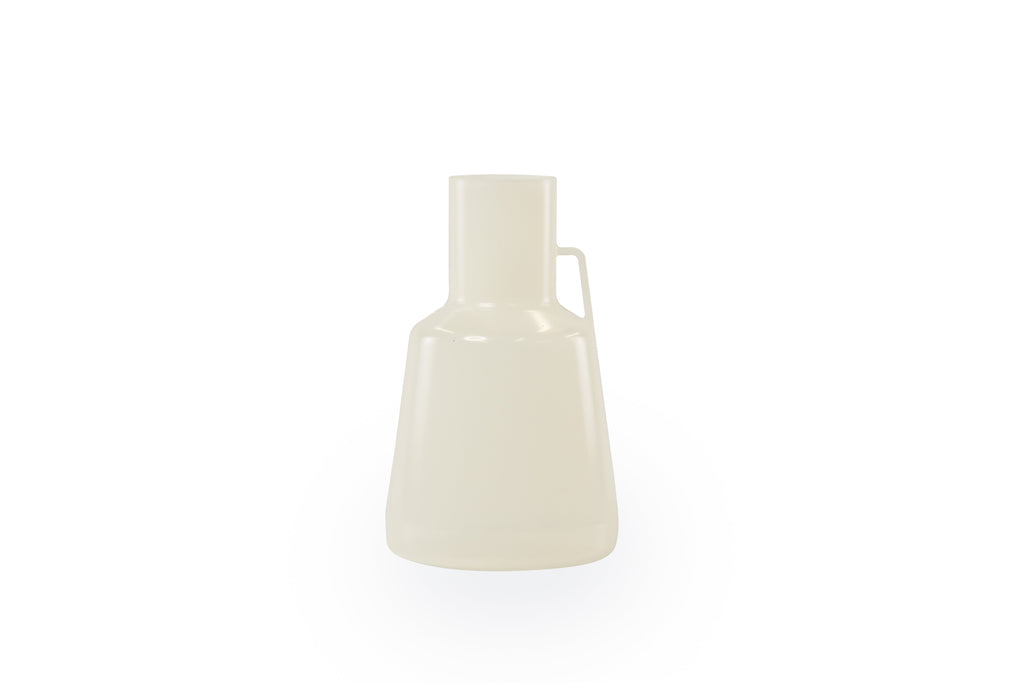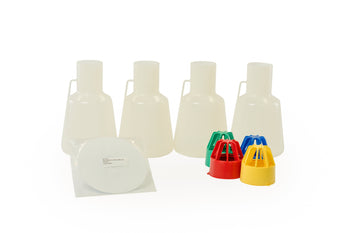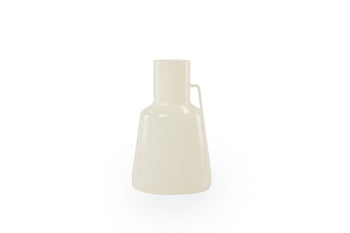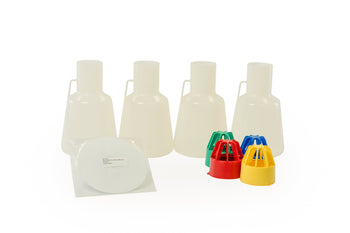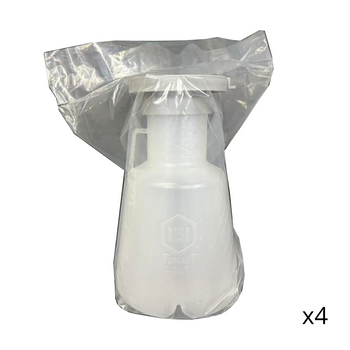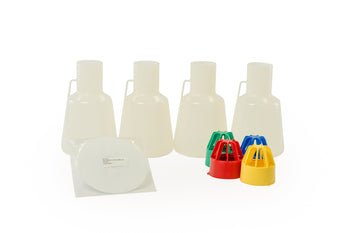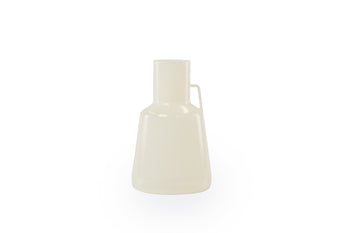
TUNAIR™ Polypropylene Erlenmeyer Flasks: Superior Growth and Productivity
The Full-Baffle TUNAIR™ Polypropylene Erlenmeyer flask system, by IBI Scientific, is a patented solution designed for microbiology and biotechnology applications. These Erlenmeyer flasks offer optimal growth conditions for aerobic microorganisms, mammalian cells, and plant cells, surpassing standard flasks in culture growth and productivity.
Key Features:
- High Oxygen Absorption: Unique baffling and turbo-vane closure design enhance dissolved oxygen availability and improve cell yields. Learn more about high-oxygen absorption flasks.
- Enhanced Design: Six baffles create a propeller motion, ensuring efficient mixing. Working volume is 1L. Check out our Full-Baffle Flask Collection for more options.
- Durable Material: Made from polypropylene, resistant to most solvents. Explore our polypropylene lab equipment for additional products.
- Easy Maintenance: Clean by soaking in water with a light detergent, then air dry. Caps and filters are sold separately. Find more cleaning and maintenance tips for lab glassware.
Optimize your lab with TUNAIR™ polypropylene Erlenmeyer flasks for superior performance and reliable results. Discover related microbiology tools on our website.
- Accessories
- Technical Information
- Baffled Flask FAQs
- Specifications
- Other Erlenmeyer Flasks
Cell Growth Evaluation of Commonly Used Shake Flasks:
TUNAIR™ flasks were compared to conventional flasks using four different types of microorganisms; Escherichia coli, Saccharomyces cerevisiae, Penicillium avellaneum, and Streptomyces chartreusis. The aeration capacities of the shake flasks were determined by the sulfate oxidation method, and the values shown below are presented as oxygen absorption rate (OAR) in mM oxygen/L/Min. The growth rates of E.coli and S.cerevisiae were expressed as optical densities (OD) at 555 mM. For S.chartreusis and P.avellaneum growth rates were evaluated by percent sedimentation. For E.coli and S.cerevisiae, the growth rates were determined after an 18-hour incubation period; for S.charteusis, a 24-hour incubation period; and for P.avellaneum, a 72-hour incubation period. Growth and OAR evaluations were carried out with 3-9 replicates and statistically analyzed using Turkey’s w-procedure. See results below.
Growth Chart:
| OAR Value | OD @ 555 mM | % Sedimentation | |||
|---|---|---|---|---|---|
| Flask | mM O2/L/Min. | E.coli | S.cerevisiae | S.chartreusis | P.aveilaneum |
| TUNAIR™ Full-Baffle | 4.25 | 7.09 | 5.63 | 19.7 | 3.3 M |
| TUNAIR™ Half-Baffle | 1.22 | 5.36 | 5.57 | 27.73 | 30.50 P |
| Triple Indented Flasks | 2.47 | 5.97 | 5.31 | 19.20 | 9.50 MP |
| Unbaffled Erlenmeyer | 0.52 | 5.97 | 5.19 | 17.37 | 25.10 P |
Growth Morphology:
M, mycelial; P, pellet; MP, mixed mycelial. The mycelial growths mostly adhered to the walls of the flask, which accounted for the low overall sedimentation value.
Reference Papers:
1. Method to Increase the Yield of Eukaryotic Membrane Protein Expression inSaccharomyces Cerevisiae
2. Optimisation of Recombinant Production of Active Human Cardiac SERCA2a ATPase
What is a Baffled Flask?
A baffled flask is a type of laboratory flask that features built-in baffles—raised ridges or indentations along the inner walls. These baffles disrupt the circular motion of the liquid when the flask is agitated, creating more turbulent mixing. This enhanced mixing improves the oxygen transfer rate and the overall efficiency of the culture process, making baffled flasks particularly useful in microbiology and biochemical research.
What is the Difference Between Baffled and Unbaffled Flasks?
The primary difference between baffled and unbaffled flasks lies in the internal design. Baffled flasks have ridges or indentations that create turbulence and improve mixing, while unbaffled flasks have smooth walls that result in a less vigorous and more uniform liquid motion. The enhanced mixing in baffled flasks leads to better aeration and nutrient distribution, which is crucial for cultures that require high oxygen levels.
What is Shake Flask Culture?
Shake flask culture is a common method used in microbiology and biochemical research to grow microorganisms or cells. In this technique, cells or microorganisms are cultured in flasks that are placed on a shaking platform. The shaking motion enhances oxygen transfer and nutrient mixing, promoting optimal growth conditions. Baffled flasks are often used in shake flask culture to improve aeration and mixing efficiency.
What is the Difference Between a Bioreactor and a Flask?
Bioreactors and flasks are both used for culturing cells or microorganisms, but they differ significantly in complexity and functionality:
- Bioreactor:
- Complexity: Bioreactors are more complex and can control various parameters such as temperature, pH, dissolved oxygen, and agitation rate.
- Scalability: They are designed for large-scale production and can handle much larger volumes than flasks.
- Automation: Many bioreactors have automated systems for monitoring and controlling the culture environment.
- Flask:
- Simplicity: Flasks are simpler and more straightforward, typically used for small-scale cultures.
- Manual Operation: They rely on manual methods for mixing and aeration, such as shaking.
- Volume: Flasks are limited to smaller volumes compared to bioreactors.
Baffled flasks serve as an intermediate step between simple flask cultures and more complex bioreactor systems, offering improved mixing and aeration without the need for sophisticated equipment.
Benefits of Using Baffled Flasks
- Improved Mixing: The baffles create turbulence, enhancing the mixing of the culture medium.
- Enhanced Oxygen Transfer: Better mixing leads to increased oxygen transfer rates, supporting aerobic cultures.
- Optimal Growth Conditions: The improved aeration and nutrient distribution result in better growth conditions for microorganisms and cells.
Incorporating baffled flasks into your laboratory setup can significantly enhance the efficiency and outcomes of your shake flask cultures, making them an invaluable tool in research and development.
Flask Dimensions:
Flask Size: 2.5 L
Working Volume: 1 L
Base Diameter: 6.50” [16.51 cm]
Neck Diameter: 3.00” [7.62 cm]
Height: 10.75” [27.31 cm]
Height with cap in place = 12.75"
Weight: 0.02 lbs. [0.008 Kg]
Mixing:
Full-Baffle (6 Baffles): Propeller Motion
Shaker Speed:
1” Throws: 300-400 rpm or possibly higher
2” Throws: 150-200 rpm or possibly higher
Material:
All TUNAIR flasks and caps are constructed of chemical resistant polypropylene. All flasks and caps are fully autoclavable.
300 ml flask:
Allows for approx. 150 ml (max) of working volume for culturing cells
2.5 Liter flask:
Allows for approx. 1 liter (max) of working volume for culturing cells
Full-Baffle:
The bottom inside of the flask has 6 raised baffles. This configuration will generate 4 small propeller vortexes within the media inside the flask when fastened to an orbital shaker. The full-baffle configuration allows for slower operational rpm of the shaker while maintaining the vortexes within the media. The full-baffle flask is ideal for growing E.coli providing superior growth rates and cell densities.
Two Piece Cap:
The 300 ml flask and 2.5 L flask both have a special cap and filter system that promotes gas exchange and maintains sterility of the growth culture during use. The inner portion of the cap unsnaps from the outer portion by pushing in the tabs on the side of the cap assembly and then pulling the insert out.
0.2-micron filters:
There are two different types of 0.2-micron filters available for the TUNAIR flasks. These filters allow for maximum gas exchange while maintaining sterility.
Dri-Gauze – This is a paper filter than can be used approx. 6 to 8 times before having to be replaced. This filter can be autoclaved while in the cap, on the flask, for 6 to 8 times.
Silicone – This is a silicone filter that will last the life of the flask. This filter can be autoclaved while in the cap and on the flask for many times.
Cap & Filter assembly:
Once you have the 2-piece cap assembly apart (either the 300 ml cap or the 2.5 L cap) place the corresponding filter size inside the cap and the re-assemble the inner and outer cap pieces making certain to align the tabs with their associated holes. Once clipped into place, make certain the filter completely covers the cap assembly openings.
Attaching the flasks to your shaker:
IBI TUNAIR flasks can be used with nearly all standard shakers and shaker clamps. The 2.5-liter flask typically fits best into the 2-liter shaker clamp. The 300 ml flask typically fits best in the 250 ml shaker clamp.
Preparing and Cleaning the TUNAIR flask:
Your TUNAIR flasks are constructed of polypropylene plastic which allows them to be autoclaved. Once you have prepared your media inside the flask you can place the cap & filter on the flask and insert into the autoclave. Set the autoclave for wet cycle.
Once you have harvested your cells, wash the TUNAIR flask in a mild dish soap such as Dove Dish Soap then rinse well with DI water. Do NOT rinse the Dri-Gauze filter between uses. The silicone filter can also be rinsed with DI water if needed. Observe the condition of the filters between runs to make certain there are no holes or tears in the filter. If there are, replace the filter immediately.
Check out some of our other Erlenmeyer Flasks:
1. Full-Baffle TUNAIR Polypropylene Erlenmeyer Flask, 300ml

2. No-Baffle TUNAIR Polypropylene Erlenmeyer Flask 2.5L

3. Half-Baffle TUNAIR Polypropylene Erlenmeyer Flask, 300ml

4. No-Baffle TUNAIR Polypropylene Erlenmeyer Flask Full Kit, 300ml


